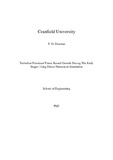JavaScript is disabled for your browser. Some features of this site may not work without it.
| dc.contributor.advisor | Jenkins, Karl W. | |
| dc.contributor.author | Dunstan, T. D. | |
| dc.date.accessioned | 2009-07-27T09:01:12Z | |
| dc.date.available | 2009-07-27T09:01:12Z | |
| dc.date.issued | 2008 | |
| dc.identifier.uri | http://hdl.handle.net/1826/3486 | |
| dc.description.abstract | In this thesis Direct Numerical Simulation (DNS) is used to investigate the development of turbulent premixed flame kernels during the early stages of growth typical of the period following spark ignition. Two distinct aspects of this phase are considered: the interaction of the expanding kernel with a field of decaying turbulence, and the chemical and thermo-diffusive response of the flame for different fresh-gas compositions. In the first part of the study, three-dimensional, repeated simulations with single-step chemistry are used to generate ensemble statistics of global flame growth. The surface-conditioned mean fluid-velocity magnitude is found to vary significantly across different isosurfaces of the reaction progress variable, and this is shown to lead to a bias in the distribution of the Surface Density Function (SDF) around the developing flame. Two-dimensional simulations in an extended domain indicate that this effect translates into a similar directional bias in the Flame Surface Density (FSD) at later stages in the kernel development. Properties of the fresh gas turbulence decay are assessed from an independent, non-reacting simulation database. In the second part of this study, two-dimensional simulations with a detailed 68-step reaction mechanism are used to investigate the thermo-diffusive response of pure methane-air, and hydrogen-enriched methane-air flames. The changes in local and global behaviour due to the different laminar flame characteristics, and the response of the flames to strain and curvature are examined at different equivalence ratios and turbulence intensities. Mechanisms leading to flame quenching are discussed and the effect of mean flame curvature is assessed through comparison with an equivalent planar flame. The effects of hydrogen addition are found to be particularly pronounced in flame kernels due to the higher positive stretch rates and reduced thermo-diffusive stability of hydrogen-enriched flames. | en_UK |
| dc.language.iso | en | en_UK |
| dc.publisher | Cranfield University | en_UK |
| dc.subject | DNS | en_UK |
| dc.subject | Spark Ignition | en_UK |
| dc.subject | IC engine | en_UK |
| dc.subject | Hydrogen addition | en_UK |
| dc.subject | Displacement speed | en_UK |
| dc.title | Turbulent Premixed Flame Kernel Growth During The Early Stages Using Direct Numerical Simulation | en_UK |
| dc.type | Thesis or dissertation | en_UK |
| dc.type.qualificationlevel | Doctoral | en_UK |
| dc.type.qualificationname | PhD | en_UK |
